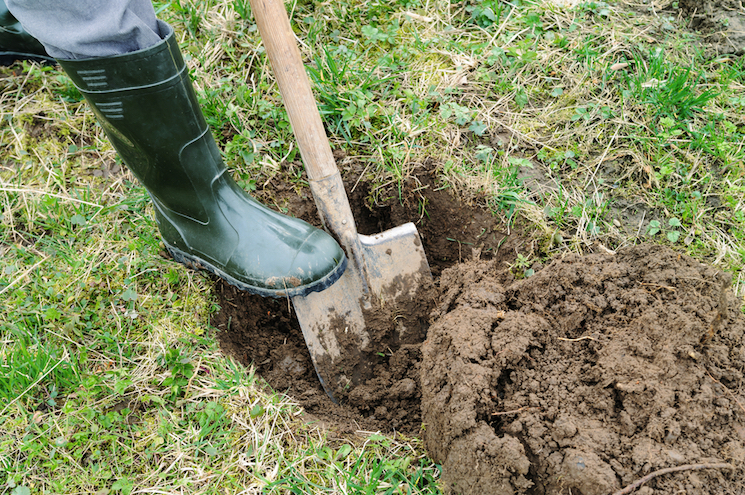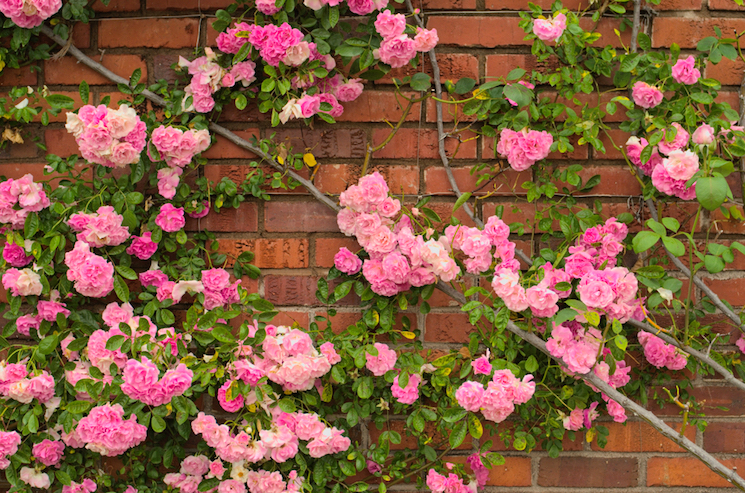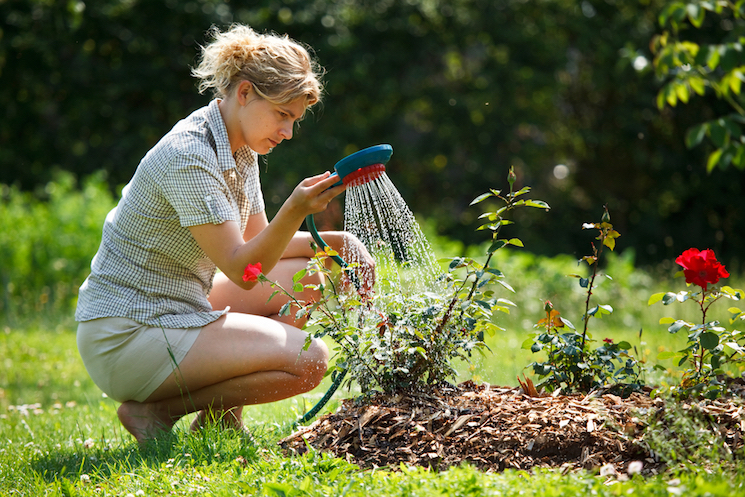Roses can transform a garden, filling it with beautiful colour and delicious perfume. And growing roses can be easy and rewarding, providing you follow some good advice.
That’s where we can help. Whether you’re looking for a patio rose, a climbing rose or rose bushes, this is how to plant and grow your favourite roses. If you’re still deciding which kind of rose you want, read our ‘how to choose a rose bush’ article. For further information on caring for roses, make sure you check out our pruning guide.
When to plant roses

Image: Shutterstock
The best time to plant roses is during their dormant season – throughout autumn and from late winter to early spring. It’s best to avoid the middle of winter, when the ground can often freeze.
When you plant your roses will also depend on how you bought them. Roses come as either bare root, container-grown or containerised plants.
Bare root roses: Bare root roses have been lifted from the ground during their dormant season (November to March) and will arrive as a bare shrub with exposed roots. This may look unimpressive at first but once planted they will soon start to send out roots and grow.
Bare root roses should be planted as soon as you receive them. But if you have to delay planting, keep your rose plants somewhere cool but frost-free. If planting is heavily delayed it may be best to ‘heel-in’ your rose. This simply means digging a trench in ordinary garden soil, placing the roots inside, and covering with soil.
Containerised roses: You’ll find containerised roses at garden centres from autumn to spring. These roses started as bare root roses and have been put in pots with earth to stop their roots drying out. Plant them out as soon as you get them home.
Container-grown roses: Roses that have been grown in a container are available to buy all year round and can be planted at any time of year. They’re usually not as strong as bare root roses because their root spread is not as big. They’re also comparatively expensive.
Where to grow roses

Image: Shutterstock
Roses are very fussy when it comes to location. To get the best result, choose a spot that offers sun, shelter, space and good quality soil.
1. Sun: Rose plants like to be grown in a sunny position. They do best with at least four hours’ sunshine a day.
2. Shelter: Choose a location that’s sheltered from strong winds which can loosen the base of the rose in the soil and damage (or even kill) it.
3. Space: Roses don’t thrive when crowded by other plants, as they have to compete for moisture and sunlight. Aim to plant your rose about a metre (three feet) away from other plants, and avoid planting under overhanging trees.
4. Soil: Well-drained soil is essential, as roses suffer when they sit in too much water. If you have a heavy clay soil, dig in some organic matter and coarse grit to improve the drainage. If you’re planting a rose where another rose used to be, it’s important you change the soil first. If you don’t, your rose is likely to suffer ‘replant disease’ – a little understood, but well-recognised disorder, which will prevent your new rose from thriving.
How to plant bare root roses

Image: Shutterstock
With just a little care and attention, your bare root roses will get off to an excellent start when planted in the ground. Just follow these simple steps:
1. Soak the roots of your bare root rose for 2-3 hours prior to planting.
2. Dig a planting hole that’s wide enough to accommodate the roots comfortably and deep enough so that the bud union (the point where the rose has been grafted onto the rootstock) rests at soil level. The bud union looks like a bulge at the base of the shoots.
3. Improve the soil. Even if your soil is well drained, it’s best to improve it with organic matter – such as well-rotted manure, compost or recycled green waste – before planting. Mix in some slow-release fertiliser (a specific rose food is best) as roses are heavy feeders. If the soil hasn’t been cultivated recently, aim to dig the soil to about 45cm (18 inches) deep.
4. Position the rose in the centre of the hole and check the depth is correct. Laying a bamboo cane across the top of the hole and lining it up next to the stem is a good way to check you have the correct depth.
5. Gently tease out the roots. This will help them to spread out more quickly.
6. Backfill around the roots with the remaining soil.
7. Tread the rose in firmly, but not too hard.
8. Water your rose thoroughly and keep the soil moist, especially in hot sunny spells.
How to plant climbing roses

Image: Shutterstock
Walls and other solid structures can often cause the soil at their base to be dry, so plant your climbing rose 30-45cm (12-18 inches) away from the wall or fence at a 45º angle. This will enable it to receive sufficient moisture.
Climbing roses will require some support, normally in the form of horizontal wires spaced 45cm (18 inches) apart up a wall or fence and positioned about 7cm away from the wall to allow air circulation. You can also grow climbing roses over a rose arch, which is very effective.
Planting is the same as for other roses, with the bud union at soil level. After firming in, use canes to guide the shoots towards the support.
How to grow roses in containers

Image: Shutterstock
If you have heavy clay soil or just want to brighten up your patio you can successfully grow roses in containers. Containers need to be at least 30-45cm (12-18 inches) deep for bush roses, and 25cm (10 inches) deep for miniature roses.
1. Fill your chosen container with loam-based compost such as John Innes No. 3.
2. Follow the planting directions as for planting in the ground (see above).
3. Top-dress with rose fertiliser each spring.
4. Feed regularly once they begin to flower, with a liquid feed containing a high potash fertiliser (such as tomato fertiliser)
Feeding and mulching roses

Image: Shutterstock
Roses are greedy feeders and need regular fertilising to encourage healthy plants. In the spring, sprinkle a handful of slow-release fertiliser around the base of your rose, following the manufacturer’s instructions. Lightly fork it into the soil, keeping it clear of the stems.
Next, mulch your rose plant by spreading an 8cm layer of well-rotted manure, compost or recycled green waste around the base, taking care to keep a 10cm (4 inch) collar free of mulch around the stem to prevent the bark rotting.
We hope this guide has told you all you need to know about choosing, planting and growing roses. Follow these steps and your rose plants will give you beautiful blooms for years to come.
Lead image: Shutterstock

